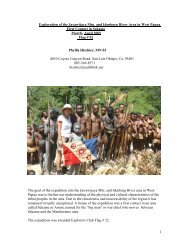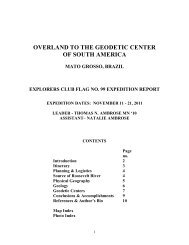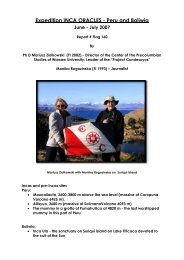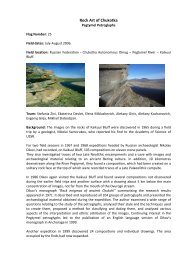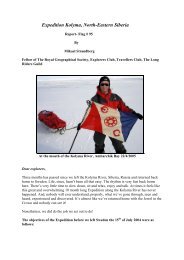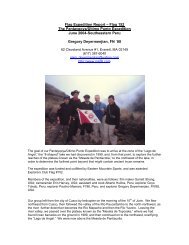the explorers journal the climate change issue - The Explorers Club
the explorers journal the climate change issue - The Explorers Club
the explorers journal the climate change issue - The Explorers Club
You also want an ePaper? Increase the reach of your titles
YUMPU automatically turns print PDFs into web optimized ePapers that Google loves.
get o<strong>the</strong>rs to <strong>the</strong> top to try and support my family.<br />
This time Lhakpa and I did it not only for our<br />
families but for all <strong>the</strong> Nepali people,” Apa said<br />
from his current home in Salt Lake City, UT, where<br />
Lhakpa also lives. “I am very proud of our team,<br />
<strong>the</strong> history we made, and <strong>the</strong> awareness we have<br />
brought to <strong>the</strong> Sherpa people.”<br />
Free of <strong>the</strong> constraints and obligations to get<br />
clients to <strong>the</strong> top, <strong>the</strong> SuperSherpas basically<br />
raced from Camp 2 to <strong>the</strong> summit, passing o<strong>the</strong>r<br />
climbers hunkered down in tents trying to acclimatize<br />
to <strong>the</strong> elevation. <strong>The</strong> SuperSherpas team<br />
started its final push for <strong>the</strong> summit on May 14,<br />
spending <strong>the</strong> night at Camp 2 (21,300 feet), and<br />
<strong>the</strong>n climbed to Camp 4—a gain of more than<br />
4,200 feet—in nine hours. After a four-hour rest at<br />
Camp 4, <strong>the</strong>y took off at 10 P.M. and summitted<br />
at approximately 8:45 A.M. on May 16. <strong>The</strong> team<br />
climbed more than 7,700 vertical feet in less than<br />
24 hours—and at <strong>the</strong> highest altitude in <strong>the</strong> world.<br />
“This trip was not as hard as o<strong>the</strong>rs when we<br />
had to help o<strong>the</strong>rs so much,” Lhakpa said. “Our<br />
Sherpa team was so strong and we didn’t have<br />
to turn around for anything. I am so very proud of<br />
how we worked as a team.”<br />
“If <strong>the</strong>re is anything good that comes from our<br />
summit…our goal would be to create a more<br />
peaceful world,” Apa and Lhakpa radioed <strong>the</strong><br />
SuperSherpas basecamp shortly after reaching<br />
<strong>the</strong> summit. “Our second goal would be to<br />
continue in Sir Edmund Hillary’s footsteps and<br />
contribute to education and improving health care<br />
in <strong>the</strong> Khumbu region, and for all Nepali people<br />
in <strong>the</strong> remote regions.” To raise awareness of <strong>the</strong><br />
PHOTOGRAPHS COURTESY OF SUPERSHERPAS LLC<br />
role of Sherpas and <strong>the</strong> need for a better education<br />
system in <strong>the</strong>ir home country, a documentary<br />
is being made about <strong>the</strong> expedition—filmed entirely<br />
by Sherpas, of course.<br />
Apa and Lhakpa never made it out of grade<br />
school in Nepal. <strong>The</strong>y both became porters for<br />
Everest expeditions at an early age to support<br />
<strong>the</strong>ir families. <strong>The</strong> men eventually proved <strong>the</strong>mselves<br />
worthy of becoming part of climbing teams<br />
and started leading people to <strong>the</strong> top. Even as<br />
<strong>the</strong> most accomplished climber on Everest, Apa<br />
still made less than 20 percent of <strong>the</strong> money<br />
Western guides pull in for taking clients to <strong>the</strong> top.<br />
Because <strong>the</strong>y spend more time on <strong>the</strong> mountain<br />
helping prepare camps for <strong>the</strong> climbers, Sherpas<br />
are also exposed to <strong>the</strong> dangers of Everest more<br />
frequently than Western climbers.<br />
Apa and Lhakpa decided it was time to draw<br />
attention to <strong>the</strong> Sherpa people and <strong>the</strong> fact that<br />
<strong>the</strong>y have been involved in some way on every<br />
expedition attempt since people started trying to<br />
conquer Everest in <strong>the</strong> 1920s. <strong>The</strong> men are also<br />
hoping that <strong>the</strong>ir success will help raise money for<br />
more and better education for all Nepali children,<br />
and create a better pay scale for Sherpas involved<br />
in expeditions.<br />
Because <strong>the</strong>y live at high elevations <strong>the</strong>ir entire<br />
lives, Sherpas do not need to go through <strong>the</strong><br />
lengthy process of acclimating <strong>the</strong>ir bodies to <strong>the</strong><br />
grueling demands of extreme heights. Amazingly,<br />
research on <strong>the</strong> Sherpas’ ability to cope with high<br />
elevations has not been done. Researchers from<br />
<strong>the</strong> Orthopedic Specialty Hospital in Utah asked<br />
Apa and Lhakpa to undergo a barrage of tests<br />
before leaving Salt Lake City for Kathmandu, and<br />
again during <strong>the</strong> climb. Results from <strong>the</strong> medical<br />
and nutritional research are still being analyzed,<br />
but it is clear that <strong>the</strong>re is something unique about<br />
<strong>the</strong> Sherpas that allows <strong>the</strong>m to excel at elevation<br />
where o<strong>the</strong>rs break down.<br />
Making it to <strong>the</strong> top is always a thrilling, but all<br />
climbers know an expedition is only a success if<br />
<strong>the</strong>y make it back home. Apa and Lhakpa were<br />
almost back to basecamp, about halfway through<br />
<strong>the</strong> Khumbu Icefall, when <strong>the</strong>y were asked to head<br />
back up <strong>the</strong> mountain to help retrieve <strong>the</strong> body of<br />
a climber who had been killed in an avalanche.<br />
Although <strong>the</strong>y had never met <strong>the</strong> Korean man who<br />
perished, Apa and Lhakpa honored his family by<br />
helping to bring his body back down <strong>the</strong> mountain.<br />
This required going through <strong>the</strong> icefall at <strong>the</strong><br />
time of highest risk, late in <strong>the</strong> day after warming<br />
from <strong>the</strong> intense sun. Many climbers, including<br />
Apa, believe <strong>the</strong> icefall is <strong>the</strong> most dangerous part<br />
of <strong>the</strong> Everest climb.<br />
<strong>The</strong> record-holders finally made it back to<br />
basecamp, albeit on a sad note, but <strong>the</strong>y still<br />
found energy enough to celebrate with <strong>the</strong> basecamp<br />
team. <strong>The</strong>y started by calling <strong>the</strong>ir families.<br />
Missing his wife and three children in Utah, Apa<br />
was in a hurry to get back to <strong>the</strong> United States,<br />
so <strong>the</strong> team wasted little time packing up camp.<br />
“We were <strong>the</strong> last to arrive and <strong>the</strong> first to leave,”<br />
Lhakpa said about <strong>the</strong> mere 22-days <strong>the</strong> team<br />
spent at basecamp, surely ano<strong>the</strong>r record for<br />
Everest expeditions. “Everybody was jealous that<br />
we had managed to make <strong>the</strong> climb so quick.”<br />
Lhakpa was also excited to get home, but he<br />
had a present to pick up for his wife Fuli. <strong>The</strong> team<br />
headed to Kathmandu, where <strong>the</strong>y were treated<br />
like royalty and swarmed by <strong>the</strong> media and wellwishers.<br />
When things finally settled down for<br />
<strong>the</strong> heroes, <strong>the</strong>y headed for <strong>the</strong> U.S. Embassy in<br />
Kathmandu, hoping to get final permission to take<br />
Lhakpa’s three children—ages 10 to 16—to North<br />
America. It took some work, but permission was<br />
granted and <strong>the</strong> team plus three returned to Utah<br />
on May 30. “I feel like we have accomplished so<br />
many goals, but it is most important that <strong>the</strong> children<br />
are here now with <strong>the</strong>ir mo<strong>the</strong>r,” said Lhakpa.<br />
“Education is so important and now <strong>the</strong>y can go to<br />
schools here and be with us.”<br />
Although <strong>the</strong>y both hint that <strong>the</strong>ir time on<br />
Everest is over, Apa and Lhakpa both say it is<br />
too soon after <strong>the</strong>ir latest expedition to decide<br />
if <strong>the</strong>y will return to attempt ano<strong>the</strong>r climb. “One<br />
never knows. We will have to see what happens<br />
in <strong>the</strong> future. <strong>The</strong> mountain will always be <strong>the</strong>re,”<br />
<strong>the</strong>y said.<br />
information<br />
For more information on <strong>the</strong> SuperSherpas Expedition visit<br />
www.supersherpas.com. For a detailed day-by-day account<br />
of <strong>the</strong> expedition with pictures, video, and notes from Mount<br />
Everest basecamp visit: www.sherpas.sltrib.com.<br />
biography<br />
Brett Prettyman has been an outdoors writer and editor for<br />
<strong>The</strong> Salt Lake Tribune since 1990.<br />
18 <strong>the</strong> <strong>explorers</strong> <strong>journal</strong>



